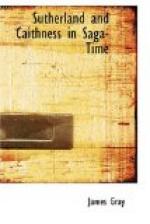Shortly after Hakon’s death in 1123, King Alexander I and his brother, David I, began to organise the Catholic Church in Scotland, and also to introduce feudalism. Even in the north of Scotland, between the years 1107 and 1153 they founded monasteries and bishoprics, and introduced Norman knights and barons holding land by feudal service from the Crown. Long thwarted in their policy by Moray and its Pictish maormors, who claimed even the throne itself, these two kings pushed their authority, by organisation and conquest, more and more towards the north. Alexander I founded the Bishoprics of St. Andrew’s, Dunkeld, and Moray in 1107, and the Monastery of Scone, afterwards intimately connected with Kildonan in Sutherland, in 1113 or 1114. David I, that “sair sanct to the croun,” who succeeded in 1124, founded the Bishoprics of Ross and of Caithness in 1128 or 1130, and of Aberdeen in 1137, and endowed them with lands. The same king[20] between 1140 and 1145 issued a mandate “to Reinwald Earl of Orkney and to the Earl and all the men of substance of Caithness and Orkney to love and maintain free from injury the monks of Durnach and their men and property,” and also in some year between 1145 and 1153, he granted Hoctor Common[21] near Durnach, to Andrew, Bishop of Caithness, whose see was then well established there, and he spent the summer of 1150, while he was superintending the building of the Cistercian abbey of Kinloss, in the neighbouring Castle of Duffus, whose ruins still stand, with Freskyn de Moravia, the first known ancestor of the Earls of Sutherland.[22]
Freskyn, probably about 1130[23] or earlier, had built this castle on the northern estate, comprising the parish of Spynie near Elgin and other extensive lands in Moray, which had been given to him in addition to his southern territories of Strabrock, now Uphall and Broxburn[24] in Linlithgowshire, which he already held from the Scottish king. Freskyn was thus no Fleming, but a lowland Pict or Scot, as the tradition of his house maintains,[25] and he was a common ancestor of the great Scottish families of Atholl, Bothwell, Sutherland, and probably Douglas. No member of the Freskyn family is ever styled “Flandrensis” in any writ.
We find in the extreme north of Scotland, in the first half of the twelfth century, apart from the Mackays, three leading families with great followings, which were destined to play an important part in the future government of Sutherland and Caithness, and with which we shall have to deal in detail later on.
First, there was the family of the so-called Norse jarls, descended in twin strains from Paul and Erlend, Thorfinn’s sons, owing allegiance to the Norwegian crown in respect of Orkney and Shetland and also holding the earldom of Caithness in moieties or in entirety, nominally from the Scottish king. Secondly, we have the family of Moddan, Celtic earls or maormors, with extensive territories held under the kings of Alban and Scotland for many centuries before this time, but dispossessed in part by the Norse. Thirdly, we have the family of Freskyn de Moravia then established at Strabrock in Linlithgowshire, who about 1120 or 1130 received, for his loyalty and services, extensive lands at Duffus and elsewhere in Morayshire, and probably about 1196 the lands in south Caithness known as Sudrland or Sutherland, from the Scottish crown.




